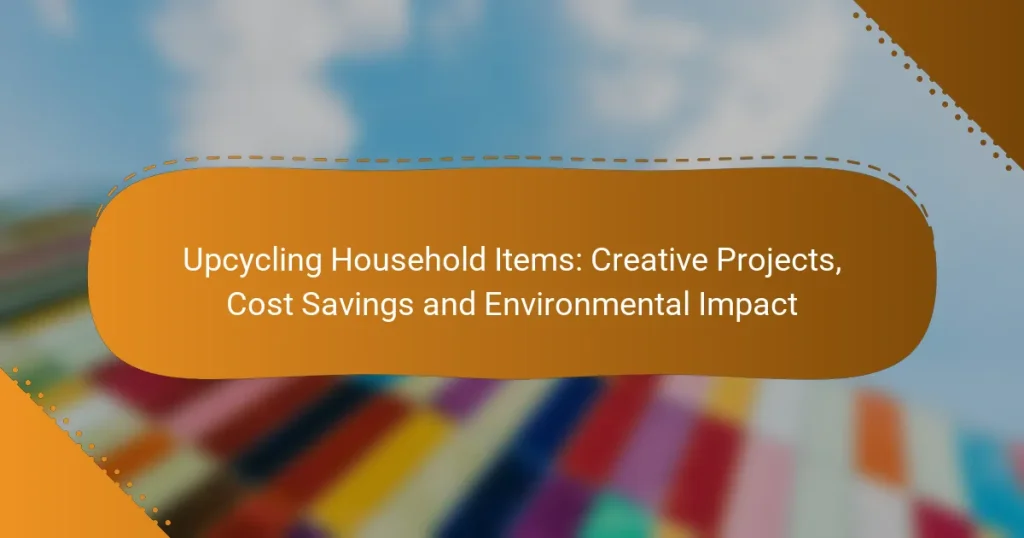Upcycling household items is a creative and cost-effective way to breathe new life into old belongings while promoting environmental sustainability. By repurposing what you already own, you can save money and reduce waste, making a positive impact on the planet. Engaging in upcycling projects not only transforms unused items into functional or decorative pieces but also helps lower your ecological footprint.
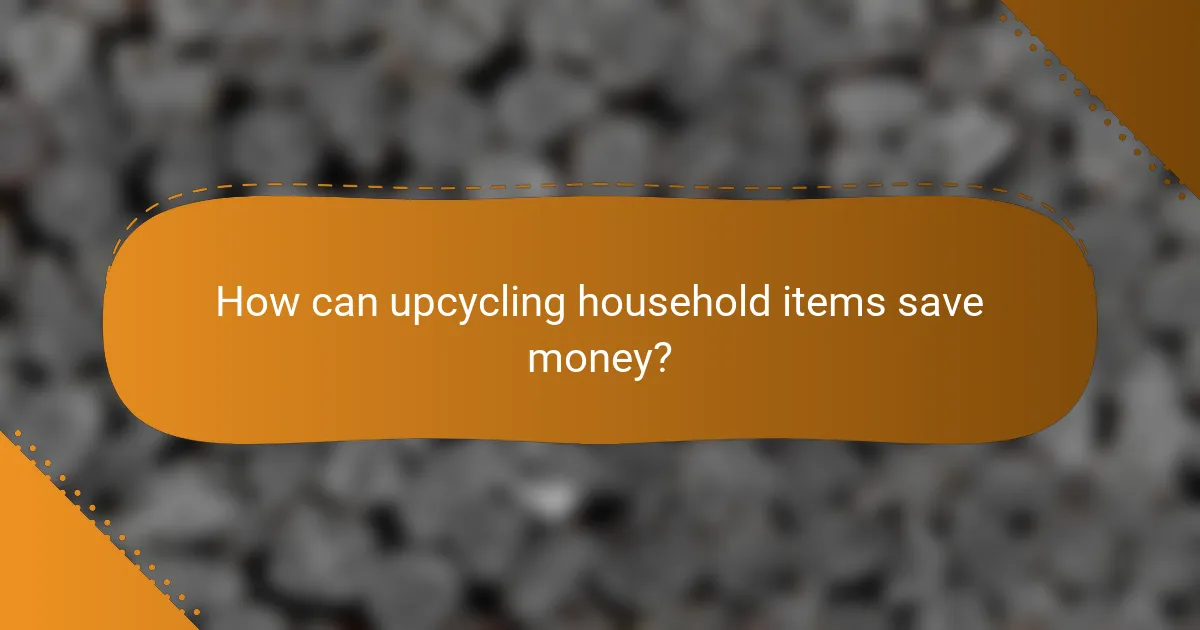
How can upcycling household items save money?
Upcycling household items can significantly reduce expenses by repurposing items you already own instead of buying new ones. This practice not only saves money but also contributes to environmental sustainability by minimizing waste.
Reduced purchase costs
By upcycling, you can avoid the costs associated with purchasing new items. For example, transforming old furniture into new pieces can save you hundreds of dollars compared to buying new. Simple projects like turning glass jars into storage containers or using old t-shirts for cleaning rags can also eliminate the need for new purchases.
Consider the potential savings: a new decorative item might cost anywhere from $20 to $100, while upcycling an existing item could cost you little to nothing. This approach encourages creativity while keeping your budget intact.
Minimized waste disposal fees
Upcycling helps reduce the amount of waste you send to landfills, which can lower your waste disposal fees. Many municipalities charge residents based on the volume of waste they generate, so by reusing items, you can decrease the frequency of your trash pickups.
For instance, instead of discarding old electronics, you can repurpose their components for DIY projects. This not only saves money on disposal fees but also aligns with eco-friendly practices, which are increasingly valued in many communities.
Increased resale value
Upcycled items often have a higher resale value compared to their original state. When you creatively enhance or repurpose an item, it can attract buyers looking for unique pieces, allowing you to sell them at a premium.
For example, a refurbished vintage chair can sell for much more than its original purchase price, especially if it has been stylishly updated. Platforms like Etsy or local marketplaces can be great venues for selling these upcycled goods, turning your creative efforts into profit.

What are some creative upcycling projects?
Creative upcycling projects involve repurposing old or unused household items into new, functional, or decorative pieces. These projects not only save money but also reduce waste and contribute positively to the environment.
Furniture transformation
Transforming furniture is a popular upcycling project that can breathe new life into old pieces. For instance, an outdated wooden chair can be sanded down and painted in a vibrant color, or a worn-out dresser can be converted into a stylish TV stand. Consider using eco-friendly paints and finishes to enhance sustainability.
Before starting, assess the condition of the furniture. Ensure it is structurally sound and clean. Basic tools like sandpaper, paintbrushes, and screws may be needed, along with a clear vision of the desired outcome.
Home decor from glass jars
Glass jars are versatile items that can be easily transformed into decorative pieces or functional storage solutions. They can serve as candle holders, vases, or even organizers for small items like buttons and craft supplies. A simple coat of paint or decorative twine can elevate their aesthetic appeal.
To create a cohesive look, consider grouping jars of similar sizes and styles together. Use them to add character to shelves or as centerpieces on tables. Remember to clean and remove labels before starting your project for a polished finish.
Clothing repurposing
Repurposing clothing is an effective way to reduce textile waste while creating unique fashion items. Old t-shirts can be turned into tote bags, while worn jeans can be transformed into stylish shorts or patchwork quilts. This not only saves money but also allows for personal expression through fashion.
When repurposing clothing, consider the fabric’s condition and suitability for the new project. Basic sewing skills may be required, but many projects can be completed with simple cutting and tying techniques. Explore online tutorials for inspiration and step-by-step guidance.

How does upcycling impact the environment?
Upcycling positively affects the environment by reducing waste, conserving resources, and lowering greenhouse gas emissions. By creatively repurposing items, individuals can minimize their ecological footprint and contribute to a more sustainable future.
Reduces landfill waste
Upcycling significantly reduces landfill waste by extending the life of products that would otherwise be discarded. For instance, turning old furniture into new decorative pieces prevents these items from taking up space in landfills, where they can take years to decompose.
Consider starting small by upcycling everyday items like glass jars into storage containers or transforming worn-out clothes into cleaning rags. These simple projects can collectively lead to a substantial decrease in waste.
Conserves natural resources
By upcycling, you help conserve natural resources that would be used in the production of new items. Every time you repurpose an old item, you reduce the demand for raw materials, which can include wood, metals, and plastics.
For example, using reclaimed wood from old pallets for DIY projects not only saves trees but also minimizes the energy and water required for new wood production. This practice promotes a circular economy where resources are reused rather than depleted.
Lowers carbon footprint
Upcycling lowers your carbon footprint by decreasing the energy consumption associated with manufacturing new products. The process of creating new items often involves significant greenhouse gas emissions, from extraction to production.
Engaging in upcycling projects, such as creating planters from old tires or turning tin cans into lanterns, can help mitigate these emissions. By choosing to upcycle instead of purchasing new, you contribute to a reduction in overall carbon output.
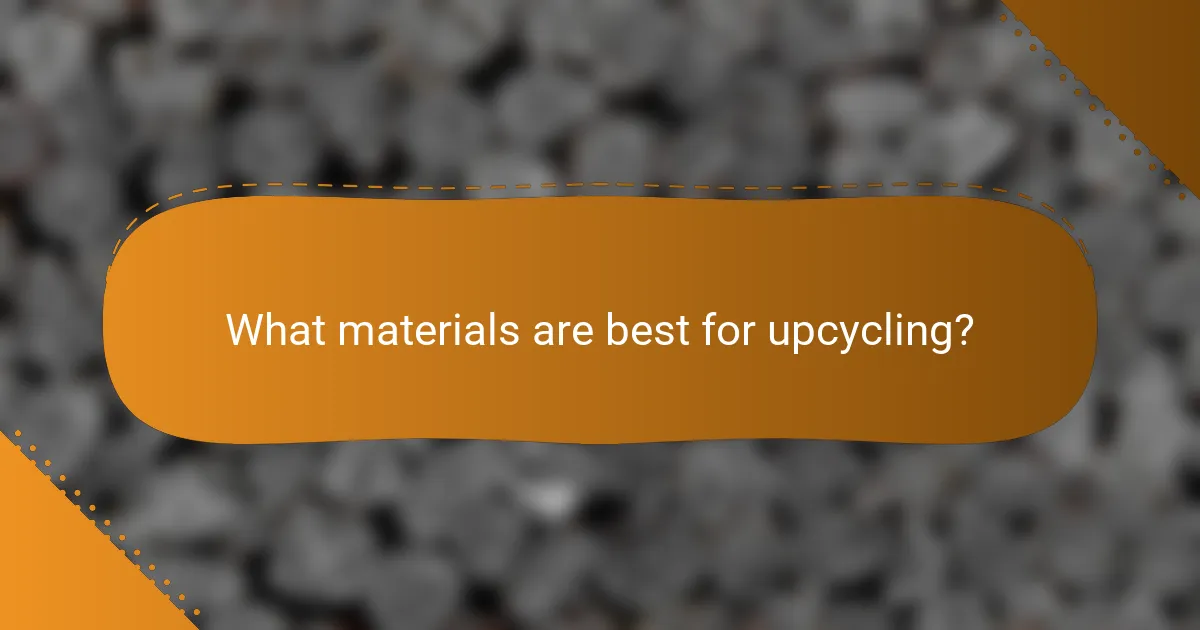
What materials are best for upcycling?
The best materials for upcycling are those that are versatile, durable, and readily available. Common choices include wooden pallets, plastic bottles, and old textiles, each offering unique opportunities for creative projects while promoting sustainability.
Wooden pallets
Wooden pallets are a popular choice for upcycling due to their sturdiness and availability. They can be transformed into furniture, garden planters, or decorative wall art with minimal effort. When working with pallets, ensure they are safe for use by checking for the “HT” stamp, indicating they are heat-treated and free from harmful chemicals.
To get started, disassemble the pallets carefully using a pry bar. Sand down any rough edges to prevent splinters, and consider applying a protective finish if the item will be outdoors. Projects like coffee tables or shelving units can be completed with basic tools and a little creativity.
Plastic bottles
Plastic bottles are lightweight and easy to manipulate, making them ideal for various upcycling projects. They can be transformed into planters, bird feeders, or even decorative lighting fixtures. When using plastic bottles, consider the size and shape to ensure they fit your intended project.
To upcycle plastic bottles, start by cleaning and removing labels. Cut them to the desired shape, and use paint or other materials to enhance their appearance. For instance, a simple bottle can become a hanging planter by cutting a hole for drainage and adding soil and plants.
Old textiles
Old textiles, such as worn-out clothes or fabric scraps, can be creatively repurposed into new items like bags, quilts, or home decor. This material is not only abundant but also allows for a wide range of creative expression. When selecting textiles, consider the fabric type and condition to ensure durability in your projects.
Begin by sorting textiles by color and fabric type. Simple sewing skills can turn old jeans into stylish tote bags or patchwork quilts. For no-sew options, consider using fabric glue or tying fabric strips together for projects like rag rugs or decorative wreaths.
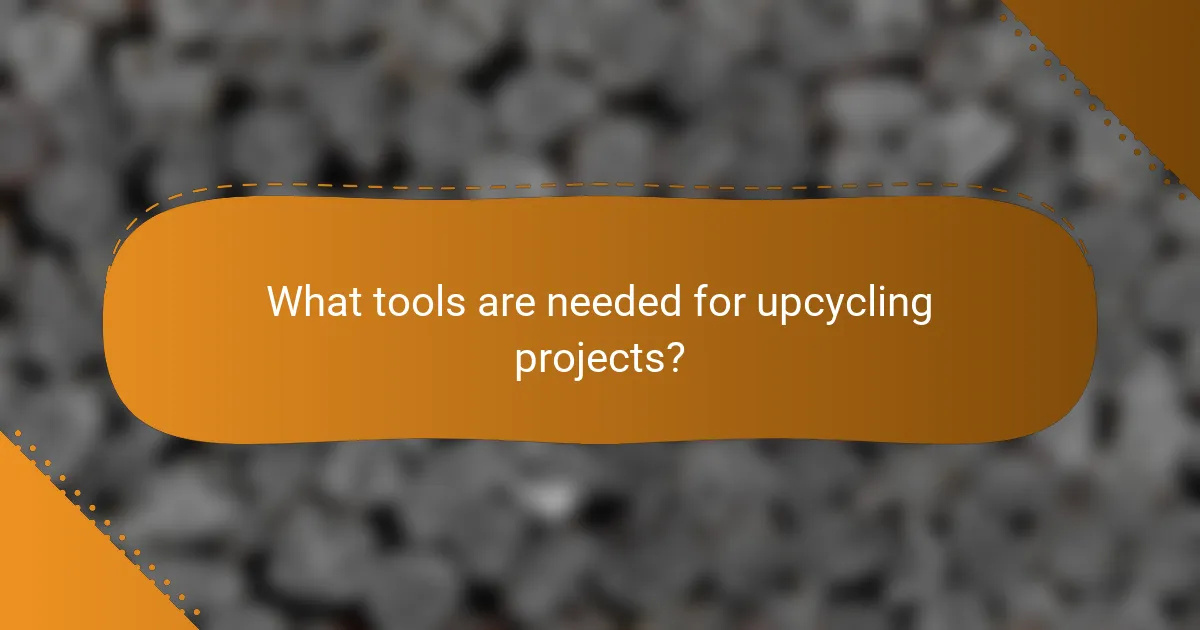
What tools are needed for upcycling projects?
To successfully tackle upcycling projects, you’ll need a mix of basic hand tools, power tools for more complex tasks, and various craft supplies. Having the right tools not only makes the process easier but also enhances the quality of your finished products.
Basic hand tools
Basic hand tools are essential for any upcycling project. Common tools include hammers, screwdrivers, pliers, and utility knives. These tools allow you to disassemble items, make precise cuts, and secure pieces together effectively.
When selecting hand tools, consider the materials you will be working with. For instance, a sturdy pair of scissors may be sufficient for fabric projects, while a strong hammer is necessary for wooden items. Investing in a good quality set can save you time and frustration.
Power tools for advanced projects
Power tools can significantly enhance your upcycling capabilities, especially for larger or more intricate projects. Tools such as drills, saws, and sanders can help you cut, shape, and finish materials with greater efficiency.
Before using power tools, ensure you are familiar with their operation and safety protocols. For example, a jigsaw is great for cutting curves in wood, while a drill can help create holes for assembly. Always wear safety gear, such as goggles and gloves, to protect yourself during use.
Craft supplies
Craft supplies are the finishing touch for many upcycling projects. Items like paint, glue, fabric, and decorative elements can transform a basic piece into something unique and appealing. Choosing the right supplies can elevate your project from functional to artistic.
When selecting craft supplies, consider the final look you want to achieve. For instance, chalk paint can give furniture a rustic finish, while fabric scraps can be used for patchwork designs. Keep an organized supply kit to streamline your creative process and ensure you have everything on hand when inspiration strikes.
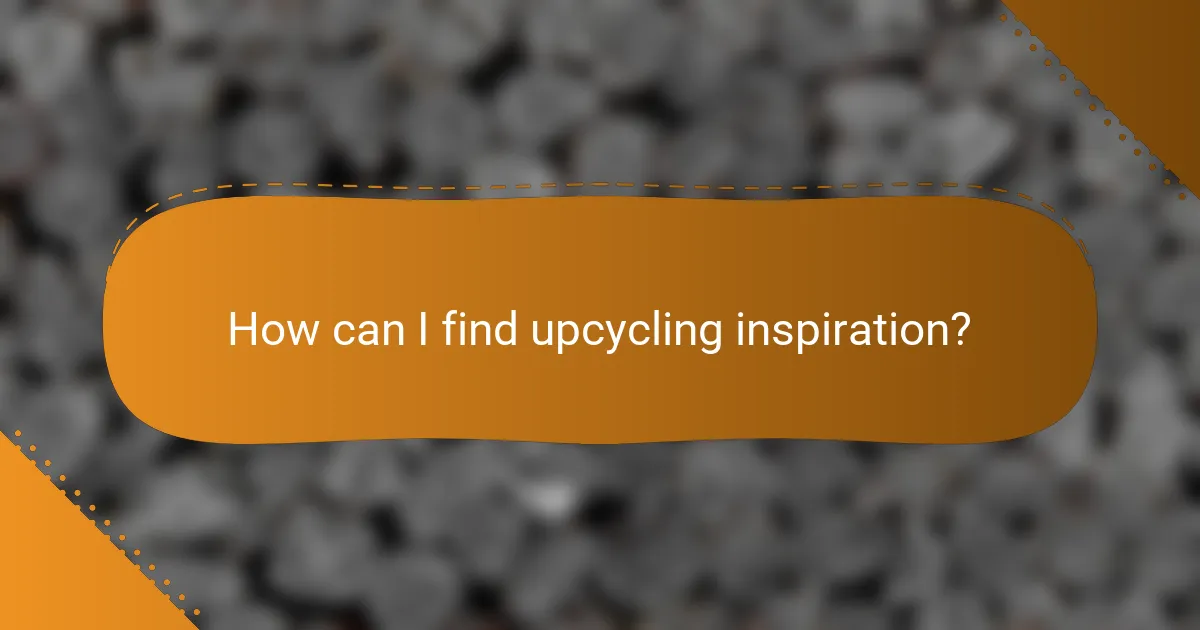
How can I find upcycling inspiration?
Finding upcycling inspiration can be easy and enjoyable. Explore various resources like online platforms, local events, and dedicated blogs to spark your creativity and discover new projects.
Online platforms like Pinterest
Pinterest is a popular platform for discovering upcycling ideas. Users can search for specific items or themes, saving and organizing their favorite projects on virtual boards. This visual approach makes it simple to find inspiration tailored to your interests.
To maximize your experience, use specific keywords related to the items you want to upcycle, such as “glass jar crafts” or “old furniture makeover.” This will yield more targeted results and help you find unique ideas.
Local workshops and community events
Participating in local workshops and community events can provide hands-on experience and inspiration for upcycling projects. Many communities host classes where you can learn new techniques and meet fellow enthusiasts.
Check local community centers, craft stores, or online event platforms for upcoming workshops. Engaging with others can also lead to collaborative projects and the sharing of ideas, enhancing your upcycling journey.
Upcycling blogs and YouTube channels
Upcycling blogs and YouTube channels are excellent resources for tutorials and project ideas. Many creators share step-by-step guides, tips, and tricks that can help you tackle your own upcycling projects.
Look for blogs that focus on your specific interests, such as home decor or fashion. YouTube channels often feature video demonstrations, making it easier to follow along and replicate the projects at home.
